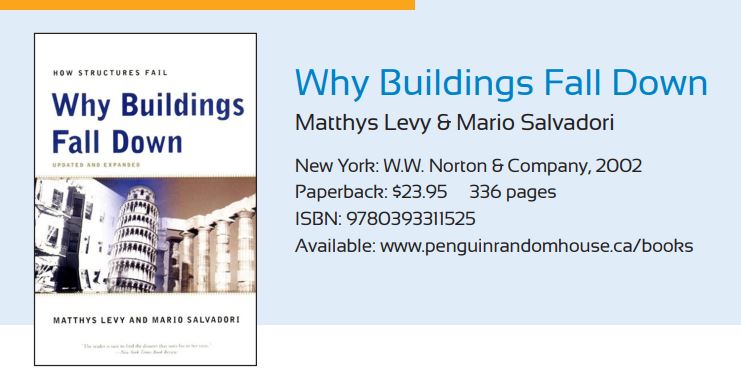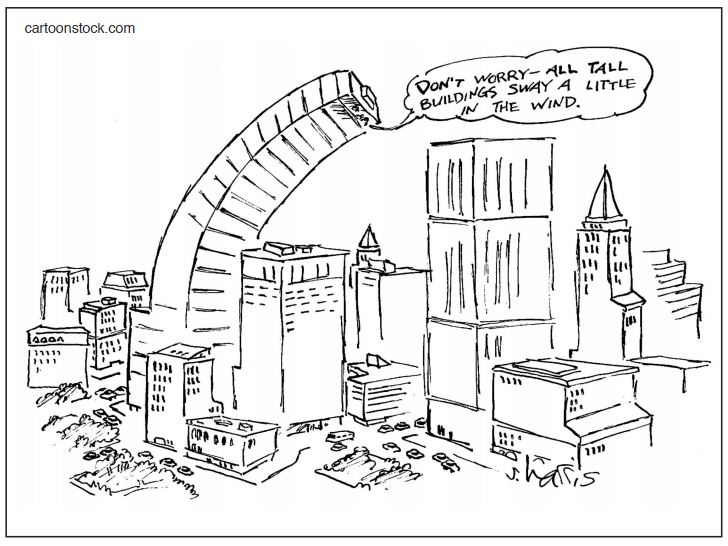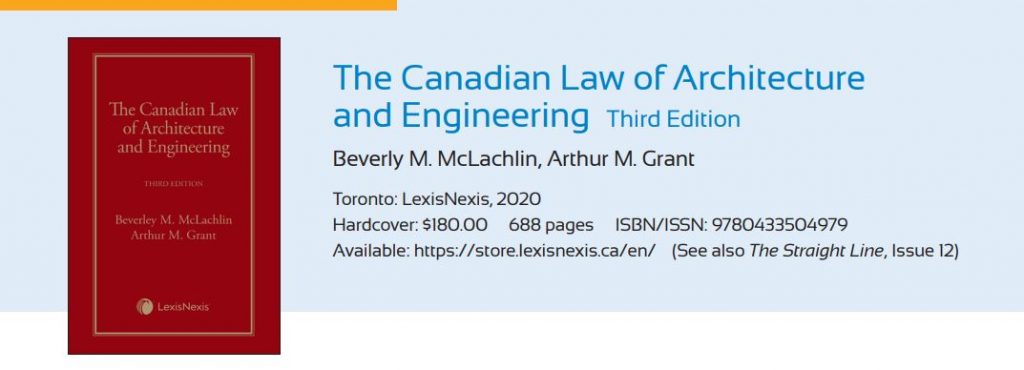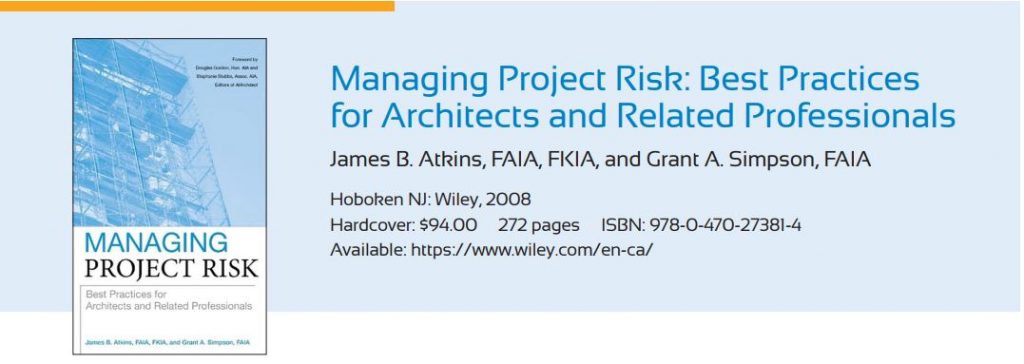The Straight Line Newsletter — Issue #16
In this issue, we discuss three important architectural books* that dig deep into the core of architectural practice: the everyday concerns, risks and rewards.
What links these books to Pro-Demnity is their focus on risk.
Each book has a distinct perspective on the subject (as do we), and provide opportunities to expand one’s understanding, thinking and approach to risk, with the upside of a potentially better outcome.
Why Buildings Fall Down
This book deals with the first Vitruvian principle: Firmness. Your buildings may work well and look
appealing, but if they don’t stand up, there’s not much point. Yet buildings continue to fall down, often unexpectedly and tragically. This book provides insights that will allow you to discuss these events more intelligently and to avoid such rare calamities in your own practice.
The Canadian Law of Architecture and Engineering, Third Edition
This one is an updated version of a classic, first published in 1987: a comprehensive rundown of the laws governing architectural practice. More than a reference book, it’s a guidebook that leads you through the hidden pitfalls of daily professional life, with an eye to helping you avoid them. Among recent issues discussed in this new edition are laws relating to copyright infringement, environmental protection, principles of contract law, and reasonable remuneration.
Managing Project Risk
Like the other two books, it strikes a balance between risks and rewards of architectural practice. In recent years, the complexities of project delivery systems, technology, and legal processes seem to present more risks than rewards, but a well-informed and careful approach to practice will easily tip the balance to the rewards side. Of particularly current importance is the often-overlooked matter of professional communications.
Download Issue #16 of The Straight Line:

In the early-morning hours of May 16, 1968, Ivy Hodge awoke in her flat on the eighteenth floor of Ronan Point Tower. …She put on her slippers and dressing gown and went to the kitchen. … She filled the kettle with water, placed it on the stove and, at exactly five forty-five, lit a match to light the burner. p 76
There are many, many reasons for buildings to fall down, and Ivy Hodge unwittingly discovered several of them.
Poor design, shoddy construction, negligent maintenance or repair, the gradual failure of small construction details, an innocent daily routine – some
or all of these things may contribute to a collapse – a chain of events that no one has foreseen, but seems to have been inevitable … in hindsight.
Rare are the cases in which one can clearly attribute a structural failure to a single undebatable cause. p. 67
Professional hindsight is really the subject of this classic book. Divided into chapters dealing with specific forms and failures, the authors carefully analyse one collapse
after another. What did the structure consist of? What ancient or unproven systems were employed? What was
overlooked, misunderstood, or misapplied?
What event or – almost always – what complex chain of events precipitated the calamity? What exactly happened at the moment of collapse? Most important: What can we learn?
Some building failures are especially informative because of the overwhelming number of contributing factors, including, but not limited to those mentioned above.
And then there are the human failures, chiefly, folly, incompetence, neglect, selfishness, and old-fashioned ignorance.
The authors’ broad experience in the field of forensic engineering provides one of the book’s major strengths. There is an abundance of technical detail and examination of the design, construction and demise of the structures. But the book’s lasting appeal lies in the authors’ gift of storytelling.

Take the memorable events of May 16, 1968 (Chapter 5). Ivy Hodge had hired a neighbour to do some repair work on the gas line to her stove. The work was done poorly, and gas began to leak slowly from a joint in the line. The reader can already see where this is going. When Ivy lit the match, there was a loud boom. But what happened next was not foreseen, by the reader, nor by the architects, engineers, builders and owners: A structural design flaw allowed a fairly mild explosion – not powerful enough to seriously injure Ivy – to blow out a support wall in her kitchen, causing several floors to cascade, and resulting in the death of four people.
Nor could they have known that after subsequent exhaustive enquiries, this faulty structural system, pervasive throughout postwar Britain, would result in hundreds of similarly constructed buildings being demolished. Just as any building failure may result from human error and/or activity, the authors continually remind us that the consequences of the failure have an even greater human dimension. In a majority of cases, we are offered dramatic eyewitnesses accounts of each catastrophe.
A particularly horrific example is the 1981 Hyatt Regency disaster in Kansas City, Mo. (Chapter 15) – at the time of writing, the worst structural disaster in US history. The authors describe the events of the evening of Friday July 17, 1981, as patrons crowded the atrium bar while others gathered on suspended walkways.
As the two walkways began to fall, the observers were seen holding on to railings with terrified expressions on their faces. … There was a large roar as the concrete decks …crashed down, in a billowing cloud of dust. … People were screaming. pp. 223–4
As for human impact, there were “114 dead and over 200 injured, many maimed for life.” The structural engineer was stripped of his licence.
The hallmark of a classic book is its ability to stay relevant, even years after publication. When Why Buildings Fall Down was first published, almost 30 years ago, computer modelling was in its infancy and sophisticated analysis still depended on a pencil, paper and a slide rule. It was also well before the 2001 World Trade Center disaster and the more recent Champlain Towers collapse in Surfside Florida. And yet, the examples cited in this book provide a wealth of insight into the possible causes of both disasters.
An engineering degree is not required to read this book, but there is a lot of arcane discussion that may call for a degree of interest in structural engineering. Some readers have complained that there is too much technical detail. And at times, the authors tell an “interesting story” that is probably interesting only to structure buffs. But, help is at hand: Appendices A–D provide an excellent crash course in structural design.
Even better, find a copy of Salvadori’s earlier book: Why Buildings Stand Up (1). What does this book teach us about our profession, our humanity and the world
in general? To start with, philosophically speaking, the lines dividing art and science, engineering and architecture,
structures and people are extremely fuzzy, since they contribute to a continuous process. But when it comes to the
practicalities of structural stability – not to mention professional responsibility – distinctions become critical.
Even more important is an understanding of how human behaviour becomes an unknown variable in every equation. There is more than enough technical detail to provide the facts of every case, but it’s the human narratives that lead to
the greatest understanding.
In the field of structure, as in any other field of human endeavor, technological improvements alone cannot guarantee a decrease of failures and may even increase it. Only a deeper consciousness of our human and social responsibilities can lead to the construction of safer buildings. p. 265
(1)
Note
1. To Salvadori, this book is a response to the popularity of the earlier book, published in 1980. This seems to echo the old saying “What goes up must come down,” which is true even of buildings, sooner or later, despite our best efforts.

Laws and Rules
Professionalism
Architecture is many things: a profession, an art, a science, a business, a tradition, a commodity, a course of study, and so much else.
But usually excluded from this list, and from the heed of many architects, is the fact that architecture is also a set of laws.
Yet there are so many laws and rules governing architecture, from municipal bylaws to aesthetic principles, that it’s easier and wiser to leave common law, tort law, statute law and contract law to the specialists. Except that, if you’re an architectural “professional,” you’re required to be aware of all the laws and rules – including those that we share with the rest of the world.
The Canadian Law of Architecture
and Engineering, Third Edition (herein-after CLAE3), might best be thought of as a guidebook – an update, a consolidation and an explanation of a legal tradition that is centuries old.
Like any good guidebook, it provides some background and points you in the right direction. It defines and describes the points of interest and tells you what to watch out for – the rest is up to you.
This report is intended as a guide – really, a guide to a guide. Nothing that follows should be considered as advice, or as a substitute for the more accurate information contained in the book, or available from your lawyer, insurer, or professional association.
The word “professional” is repeated throughout the book. This is understandable, since in any profession, the
protection of the public is paramount. In fact, according to Statute Law, “The principal object of the Architects
Act, R.S.O. 1990, c. A.26 is to serve and protect the public interest.”
We may be tempted to suppose that our dedication to the general public is just a formality – a mass of humanity whose general well-being is in our hands. To a
large degree, this is true: our obligation is not just to our clients but to everyone affected by what we do. More specifically, there is a responsibility that the legal and architectural professions both share: the buildings that we create and the laws that govern them affect the lives of individual people – professionals, clients, consultants, owners, tenants and innocent bystanders.
Throughout this book you will find many examples of
how people’s lives are affected by the laws governing the profession. The law, like architecture, doesn’t govern inanimate forms and spaces; it governs the behaviour
of people.
The significant characteristic of the professions is that they depend on confidence of two kinds for their effective pursuit – the personal confidence of the client in the technical competence of the architect or engineer and the confidence of the public at large in the integrity and ethical conduct of the profession as a whole. p. 41
Content & Form
CLAE3 is eminently readable, but don’t expect it to engage you like David Croft’s Claims Stories. This book is about people problems, but the human drama is mostly left for the reader to infer – and perhaps relate to his or her own situation. To illustrate important points, there are facts and precedents, with many descriptions of actual court cases (Table of Cases at the front of the book cites more than 1300).
Some of these you may recognize from Pro-Demnity publications, but here gritty details are excluded, while names a and places are featured. Don’t be discouraged by the footnotes. There are lots of them. In some instances, they are simply a dense list of relevant cases, of interest, mostly, to lawyers. But hidden among these notes, you will find gems – strange legal anomalies, surprising verdicts and valuable pointers. To make things easier, the book is organized into chapters that deal with the aspects of professional practice to which laws might be expected to apply – PART I,
Legal Principles (NB Chapters 10 and 11, dealing with liability and insurance); PART II, Contracts. If you’re in the habit of judging a book by its cover, suspend your judgment this time. CLAE3’s stodgy law-book outward appearance is an effective camouflage for the highly readable, well-structured contents.
Usefulness
There are three ways to put this book to work. The most obvious one is as an office resource and referral guide, to help you find solutions to problems of current or imminent concern. This use is facilitated by the chapter organization and the extensive index. But the book can’t possibly answer every question because, first, no two cases are the same; second, CLAE3 covers the whole country, with two different law codes; and third, the answer you want may be distributed over several chapters.
A second method is to read the book from beginning to end (probably not in one sitting). However, and possibly more
enjoyable, is the third method: Wander through the text, stopping at things that interest you (don’t neglect the footnotes).
CLAE3 may capture your attention in unexpected ways. Whatever your approach, reading this book in its entirety, and even memorizing every page, won’t make you a legal expert, even though it is the authoritative voice on the subject – to begin with, there are the case references and footnotes that you will want to ponder and dig into. However, having a familiarity with CLAE3 will definitely make you a better-informed professional, and much wiser when it comes to discussing a potential problem with your client, the OAA, Pro-Demnity or your lawyer.

Architecture, as we know, is a risky business. But by managing risk we can strike a happy balance between creative expression and sound business practice. The authors of this book dedicate their efforts to describing how this equilibrium may be achieved. As they suggest in the Introduction:
We admonish you to wisely balance your risks with your rewards, cherish that shingle on the front while having fun and finding fulfillment along the way. p. xi
Based on a series of articles that have appeared in AIA Architect over the years, Managing Project Risk combines the experience of two wise, witty and seasoned American architects whose observations and recommendations apply to situations that architects anywhere may encounter. Some information applies specifically to American architects. There are many references to AIA documents, but most of these have OAA and RAIC equivalents. There are a few risk-free reasons to read this book. First, it contains valuable lessons about architectural practice that you probably didn’t learn in school.
Second, it answers most of the questions you may have about risk management, even if the subject is new to you.
Third, it is an entertaining read and is easy to understand and absorb. Finally, if you are a consumer of Pro-Demnity publications, seminars, or claims services, this book will provide a refresher course – a sort of déjà vu in hardcover.
Writing about risk and reward, carries its own risks and rewards. As Douglas Gordon and Stephanie Stubbs point out in their Foreword, there is a reward in simplifying complicated and jargon-infested legal and insurance writing: It makes professional life more pleasant. But there is also the risk that oversimplification may lead to inaccuracy. The goal that Atkins and Simpson have accomplished is to simplify cautiously and explain lavishly. To aid in comprehension, the book is divided into chapters that reflect general areas of risk, including such things as the fundamentals of risk, dealing with
clients, an architect’s authority and an introspective look at what architects should be trying to do and why they should bother trying to do it.
Apart from chapters 4 and 5 (thorny issues), this book is not really a reference volume. By all means, if you’re wondering about how you should deal with site visits or drawing changes, consult these chapters immediately. But you’ll be missing some of the important and enlightening context contained in the rest of the book.
The book’s major themes can be summarized under two major headings: communications and fallibility. We are constantly advised to communicate our intentions and our actions as clearly as possible. When our clients, consultants, constructors and others don’t understand our services, a disconnect may arise. No matter how well we perform, if our work doesn’t satisfy expectations – even unrealistic expectations – there will be a lawsuit, involving costs that are increasing daily. There are no statistics to tell us how many exorbitant claims have been settled or avoided by effective communications, but there are few professional writers or speakers who don’t mention the importance of communications and management of expectations in preventing lawsuits and protecting future opportunities.
Communication failure has led to a more imminent danger. The general lack of understanding of what we do and why we do it has resulted in a gradual erosion of the stature and impact of our profession. In particular, as long as we are perceived as the person-in-charge-of-everything, in the “master-builder” role, we can expect to shoulder the blame for anything that goes wrong. Developments within the past 70 years in North America have made this position increasingly untenable and dangerous, since blame carries liability.
We are continually frustrated at the lack of understanding of architects by the general public. We are convinced that our risks would be less if everyone better understood what an architect is and does. The operative word for this piece is ‘communicate,’ since who people think we are is greatly determined by who we lead them to believe we are. p. 211.
The second theme directly related to the first, is that architects are human and humans make mistakes. No reputable contract document promises architectural perfection. Our professional charters require only reasonable competence. And yet, if it serves their agenda, owners are often inclined to expect compensation for anything that is less than perfect. There is a wide, litigation-filled gulf between reasonable competence and unreasonable perfection.
The Canadian Handbook of Practice (CHOP) devotes a good deal of text to Risk Management and architects are encouraged to read those sections. There are, in addition, many online sources of useful information, and it goes without saying that the wisdom of Pro-Demnity’s Risk Services is only a phone call or email away. But if you’re interested in being proactive, Managing Project Risk is a great place to start.
*Non-Affiliation Statement: We declare no affiliation, sponsorship, nor any partnerships with any of the publishers, authors or advertisers/promoters of the books independently reviewed by Pro-Demnity. Pro-Demnity has received no compensation or consideration for the reviews provided herein.
Our Contributor

Gordon Grice B.Arch, OAA, FRAIC is a freelance communications strategist, writer, editor and illustrator. In addition to editing The Straight Line, he is also editor-in-chief of The Right Angle Journal, and the former editor of OAA Perspectives. He has edited several dozen books; the most recent, Architecture in Perspective 36, will be available from the American Society of Architectural
Illustrators this fall.
Gord can be reached at:
Gordon Grice + Associates
Tel: (416) 536-9191 | gordonsgrice@gmail.com
The Straight Line is a newsletter for architects and others interested in the profession. It is published by Pro-Demnity Insurance Company to provide a forum for discussion of a broad range of issues affecting architects and their professional liability insurance.

